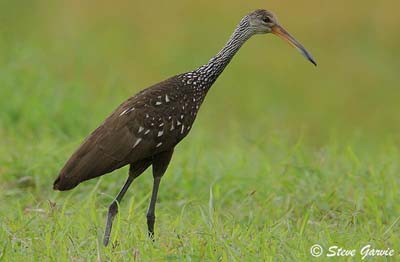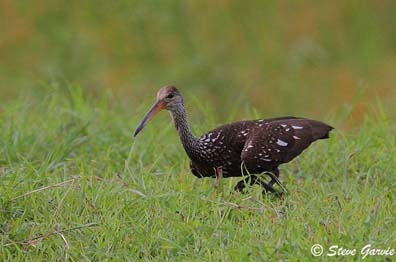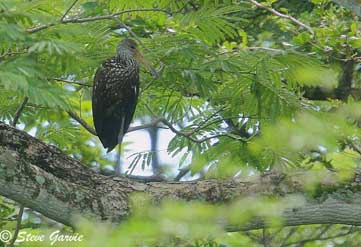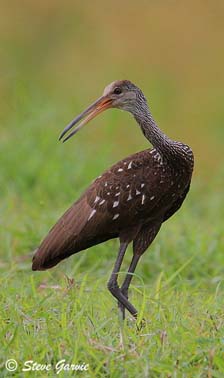
Limpkin
Aramus guarauna
Gruiforme Order - Aramidae Family
BIOMETRICS :
Length: 64-73 cm; Wingspan: 101-107 cm; Weight: 900-1300 g

DESCRIPTION:
Limpkin has dark brown or chocolate brown plumage overall, with slight bronze sheen on wings and tail. Most of its body, including head, neck, back and underparts are heavily streaked and mottled with white. Underwing coverts show white mottling, visible in flight. Wings are long and broad, and tail is rather short.
Face and neck show finer white streaks than on body, and appear paler. Bill is long, slightly down curved, and yellowish with dark tip. When Limpkin has closed bill, we can see a gap before the tip. This gap helps it in carrying and manipulating large snails. Eyes are reddish. Long legs and large, webless feet are dark greyish-green.
Both sexes are similar in plumage, but male is larger than female.
Juvenile is similar to adults, but it has narrower white spots, giving streaked appearance.
VOICE: SOUNDS BY XENO-CANTO
Limpkin’s call is unmistakable. Male gives loud wailing and screaming cries at dawn and dusk. We can hear a drawn out “kyaoh-kyaoh”, a rolling “krrrrh” or “kerr-rr-rr-owh”, a shorter “kyow” or “kaah”, and when disturbed, a sharp “bihk-bihk”.
Female is relatively silent. She may utter a short “gon”, lower than male’s voice, used in response to mate’s calls or intrusions.
HABITAT:
Limpkin lives in marshy wooded areas. It is resident in open freshwater marshes, swamp forests bordering slow-moving rivers, lake or pond shores, and mangroves.
RANGE: Limpkin is found in Florida, West Indies and from Southern Mexico to Argentina.
Limpkin is resident in its range, but northern populations may be partially migratory.

BEHAVIOUR:
Limpkin feeds by walking in shallow water, rarely in deeper water. According to some habitats, it may wade on floating vegetation that supports its weight. It probes through this mat, searching for snails. It also forages along the shores or canal banks.
It searches for food by sight in clear water. It also performs tactile searching with its bill through floating vegetation, but keeping head out of water. But it can put the head under water if necessary. It feeds mainly on freshwater large snails, leaving piles of empty shells in some sites. In order to extract the mollusc, it inserts lower mandible into the shell, and with the lower bill tip which curves to right, it uses it for cutting the muscle attachment. Shell is rarely broken. It needs about 10 to 20 seconds.
Limpkin is a terrestrial bird, but its long toes allow it to walk on large leaves and floating vegetation. It can swim well, but infrequently, with elevated wing-tips and tail. It doesn’t dive. Limpkin rests and sleeps in hidden places, or on its favourite daily perches, on the ground or dense mats of vegetation. It is usually tolerant of other bird species and humans.
Limpkin performs some territorial behaviour in breeding season. Male flies to territory boundaries for chasing other Limpkins flying through territories. Female may chase female and young, but rarely males.
In order to chase intruders, male flies at them and calls, uttering ritual loud “kreow”. Male may also perform abbreviated charging and climbing vertically with strong wing-flapping. It also performs exaggerated charging and retreating displays. Feet fighting may occurs.
When the breeding season starts, unmated female visit several territories. She may call to attract male which spends most of time at nest site, and exhibits nest-building behaviour. Female approaches nest-site and the whole process may take from a few days to a few weeks. After pair-bonding, mates rest and forage side by side until incubation. Male also performs courtship feeding, offering extracted snails to female. Copulation continues from pair formation to beginning of incubation.
Limpkin may be monogamous, but serial polyandry occurs. Female may leave mate’s territory every day for one hour, fly to unpaired male, and come back after courtship feeding and copulation.

FLIGHT:
Limpkin is mainly terrestrial, and flies only short distances with held head and neck, and dangling legs and feet. It flies with slow, shallow, but steady wing beats. It flies low, at about 3 to 7 metres, but it may perform higher flights at about 17 to 20 metres over large marsh.
REPRODUCTION:
Nest site is usually selected by male. Nest may be built in a wide variety of sites: a few cm above water on floating vegetation; among tall marsh grasses; in shrubs or stumps covered with tangled vine; in isolated pond bush in the Everglades…
Nest is well hidden, but with clear view for sitting birds. Limpkin’s nest is a platform made with woven reeds and twigs. This platform is used to elevate nesting materials above water.
Female lays 5 to 7 rufous coloured eggs, speckled with brown. Eggs are usually laid daily. Incubation lasts about 26 to 28 days, and starts when clutch is complete. Both parents share incubation. They turn the eggs, and add or adjust nest materials.
Chicks are covered with down, and leave the nest very soon after hatching. During the first week, they stay at brooding platform for brooding, resting and feeding. Juvenile usually disperse at about 13 to 17 weeks after hatching, but adults stop feeding them at about 9 to 10 weeks of age.
This species produces two broods per season, sometimes three.
DIET:
Limpkin feeds mainly on freshwater large apple snails (genus Pomacea), mussels, but also lizards, frogs, insects, crustaceans and worms.

PROTECTION / THREATS / STATUS:
Limpkin adults are preyed upon by alligators. Eggs are eaten by snakes, crows, raccoons and other aquatic mammals. They give loud alarm calls for nearby alligators, and may perform broken-wing display if necessary.
Habitat loss with wetland conversion to agriculture, flood control and human development are the largest threats in Florida. Pollution of fresh water habitats is also a problem. Invasive exotic aquatic plants degrade apple snails’ habitat in rivers and lakes.
However, populations are not endangered at this moment.
Fr: Courlan brun
All : Rallenkranich
Esp : Carrao
Ital : Serracura
Nd : Koerlan
Russe : Бразильская арама
Sd : Ralltrana
Photographs by Steve Garvie
RAINBIRDER Photo galleries
Text by Nicole Bouglouan
Sources:
HANDBOOK OF THE BIRDS OF THE WORLD Volume 3 by Josep del Hoyo-Andrew Elliott-Jordi Sargatal - Lynx Edicions, 1996, 821 pages - ISBN : 8487334202
Wikipedia (Wikipedia, The Free Encyclopedia)
All About Birds (Cornell Lab of Ornithology)
CREAGUS@Monterey Bay (Don Roberson)
What Bird-The ultimate Bird Guide (Mitchell Waite)
Arthur Grosset's Birds (Arthur Grosset)
Animal Diversity Web (University of Michigan Museum of Zoology)